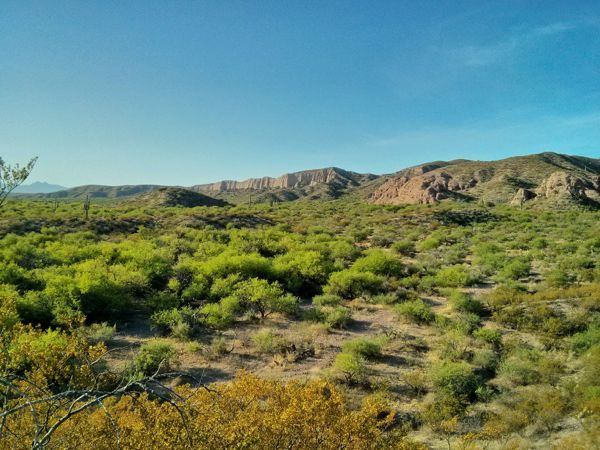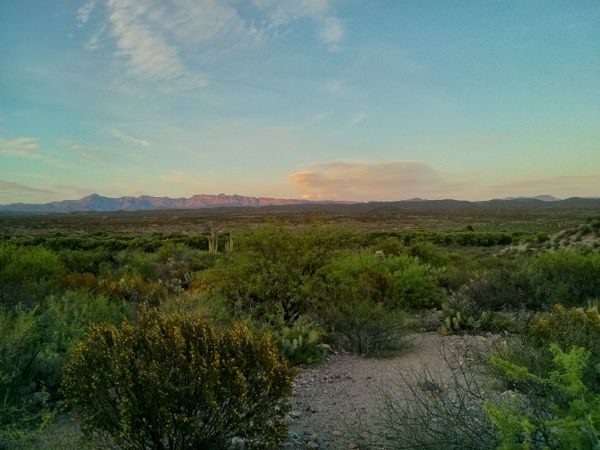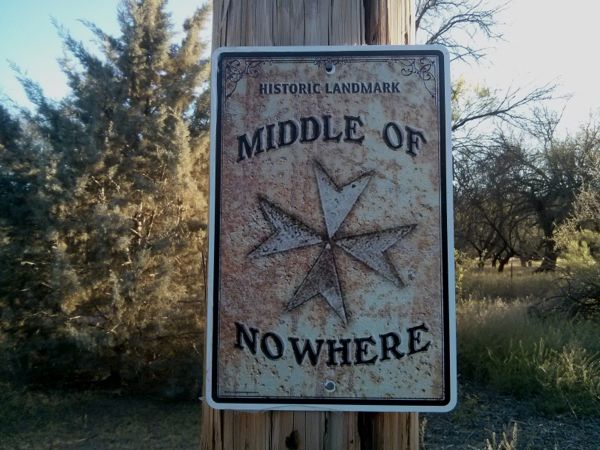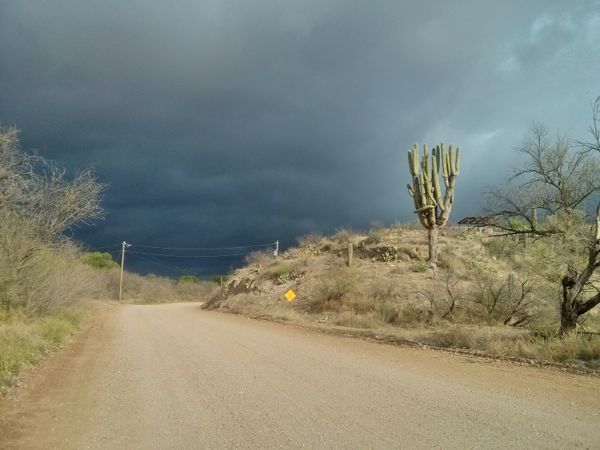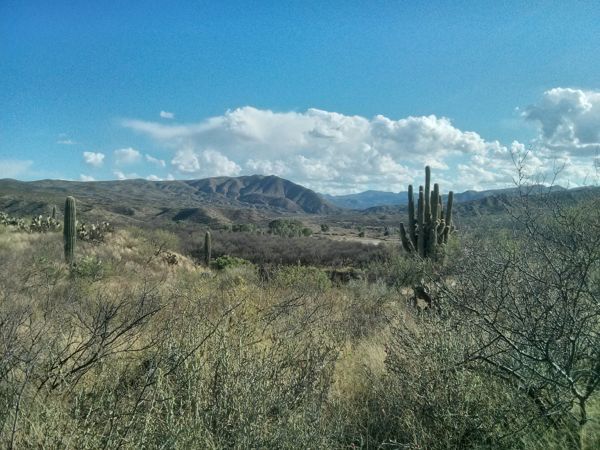Desert home
 May 27, 2020
May 27, 2020 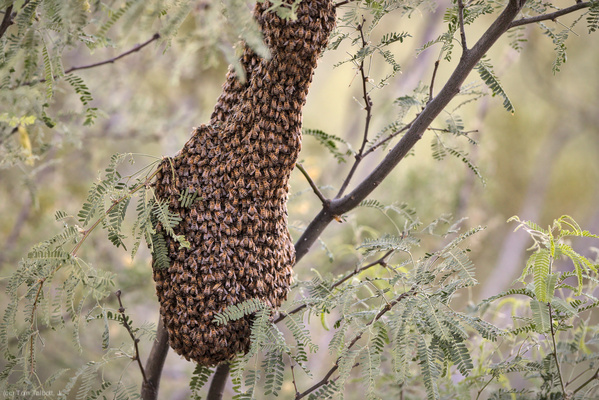 Photo Credit: Tom Talbott, Jr.
Photo Credit: Tom Talbott, Jr.
The swarm of bees is still there this morning, hanging pendulous from the branches of the mesquite like a giant oriole’s nest, each bee perfectly still and in alignment with its neighbor, wings all pointing down like the hair on a sleeping cat.
Judging by its diameter around the branches, the mass must be layered five or ten bees deep. I wonder what the ones at the bottom feel like, with the weight of their hive-mates pressing down on them. And what would it take to disturb them? As the sun touches the cluster—dappled light filtered through the mesquite leaves—they do not seem to be in any hurry to move. Though the surface bees are awake and stretching now, only scattered bees are leaving and just as many returning; the whole bee-mass seems to be steaming slightly, like a pot just starting to come to a simmer.
The whole thing looks more like some kind of organism than a collection of single insects. A very small furry sloth perhaps, hanging two-legged from a forked “V” in the mesquite. As the day-breezes pick up, the solid blob sways a little—it’s loose, but has weight to it, like a wadded-up piece of cloth that might unfurl to stream out in the wind at any moment.
They arrived late yesterday afternoon, all at once, the swarm a diffuse blur overhead, more sound than substance. It circled, then descended into the bush on the other side of the truck, collecting itself somehow into this compact cluster, hundreds of bees compressed into a ball, a foot-and-a-half long and maybe eight-inches in diameter at its thickest. Though we had seen the swarm arrive—and stepped into the screen room just to make sure it knew we would give it room to pass—we only discovered the bee-ball later, at bedtime, when they had already gathered in for the night.
I go back in the trailer for an hour to do food prep for the day while it is still cool—keeping our tiny fridge closed during the hot part of the day is essential to it actually doing its job—but when I come back out the bees are in pretty much the same state. I don’t know why I expected them to be up-and-at-‘em at first light. Maybe I am taking that whole “busy as a bee” thing too literally. But here they are, with the sun well above the horizon on its fast-track up to the very tip-top of the blue sky, still clinging to their branch like teenagers in bed on a school day.
I take another break from bee-watching and finish the food prep and find duct tape to help Tom tape some popsicle sticks where the latch for the cargo door on the trailer catches so the latch will make a tighter seal and keep the bugs out. This ingenious use of the materials-at-hand works, though we think we will have an even tighter seal if we buy another box of popsicles. Perhaps two boxes…
After all this, it is getting on toward 9:30 and now it is definitely hot, but the bee-blob hasn’t budged. The whole outer layer is doing a slow churn, and the ball looks a little expanded with the bees moving about, but I am starting to think that this pot may not boil while I am watching it. Here and there all over the cluster, a few solitary bees are vibrating wildly, their whole bodies shaking furiously as though possessed by the spirit of God. For a moment, that one bee is all soul, fur flying, lungs flapping in the wind, wings and legs and stripes a dizzy blur. Then it disappears into the slow-moving mass and the day snaps into normal mode again.
I leave once more to put the lentils and rice in the solar oven (which already registers 400 degrees inside) and when I come back the spirit has spread; now there are bees vibrating in multiple places at once, and the whole bee-ball is awake and moving restlessly; individual bees look like they are searching for something, the slower ones nudging and nosing their neighbors, the vibrating ones trampling over the others in their hurry. On the underside of the ball, the lowest bees hang loosely—some just by their front legs.
Lunch comes and goes, and while Tom is doing the dishes, I check back again. Still there! Though now the mass is drooping seriously, dripping like a softened candle under the weight of the clinging insects. They are still moving on the surface, but there don’t seem to be as many coming and going. The whole thing looks heavy and tired under the hot noon sun—which may be mostly a projection on my part. How long are they going to stay? I wonder, thinking of the Far Side cartoon in which the Joneses feign death to get their houseguests to leave. These bees don't seem like they would notice if I was alive or dead, so I resort to knowledge as my offensive strategy, and go to find one of the few books I brought with me, which just happens to be Hoyt's The World of Bees.
According to Hoyt, when a bee colony decides to swarm, they fly in tighter and tighter circles, and usually settle somewhere on a tree limb. If the queen is with the cluster, the cluster will hold and grow. It will be a huge, seething, dripping, shapechanging mass of bees, wonderful to see…and may remain for anything from fifteen minutes to several days. During this time, scouts are sent out…on the lookout for the perfect home.
These scouts do their ‘wagging’ dance when they return…the same dance they do inside the hive to tell their sisters where a new source of nectar is to be found. When the scouts return they dance for whatever discovery they have made. And their excitement is in direct proportion to the mental misgivings they have in regard to their find. It if is adequate and that is all, the dance is done pretty listlessly. If it is perfect…the dance will be done with great enthusiasm.
And here’s the really amazing part. Other bees go to check out the places being danced for most vigorously. Half-hearted dancers stop and go to see what the more enthusiastic bees are so delighted about. Pretty soon the dancing for the one becomes nearly unanimous. This is when the swarm takes flight.
2:45. I check again. The sun is a big hot hand over the whole sky, pressing relentlessly. It is too bright, too exposed, even in the shade. The swarm has continued to sag, and it now looks disturbingly like a dead animal—perhaps a tiny goat hung by its hind feet for butchering. I can’t get the image out of my mind and the squirming insects now look like maggots on a rotten carcass rather than the beautiful gold-furred divinities of the dawn. Bees are coming and going regularly, a handful at a time, and there are several bees “dancing” at once. I try to see if the direction of their dances coincides—maybe several point in the same direction? When I turn to look in that direction the first thing I see is our nearby yurt and screen room. Huh....... Surely they aren't thinking about staying......here!
The wind has really picked up, and the lengthening strands of bees flap with an elastic weight like the sagging flesh on the back of an arm. The tarps on our trailer that shade its sides are threatening to set sail in the strong gusts, so we decide to take them down for the day. Just as we have removed the tent poles, at 2:59 pm, we hear a sudden roar, and peer out from under the partly-dismantled awning to see the whole swarm up in the air again, swirling in a fast circle over the cluster-site. Once every bee is off the branch, the circle widens and lifts and then slowly gyres toward us; then slowly spins over us as we huddle under the fabric; then slowly drives off toward the yurt (Keep going! Tom mutters); then slowly surrounds the top of the yurt (Keeeep Going…..!); then finally—to our immense relief—heads slowly on up the slope. The last we see, they are circling in a slow bee-funnel toward the top, disappearing over the ridge in a whirl of unseen sound.
The driveway seems suddenly very quiet and very still. We breath a sigh of relief at their decision, and continue to tie up our awning and think about supper. I hope they like their new home as much as we like ours.
Hoyt, M. (1965) The World of Bees. New York: Bonanza Books.
 Creatures
Creatures 